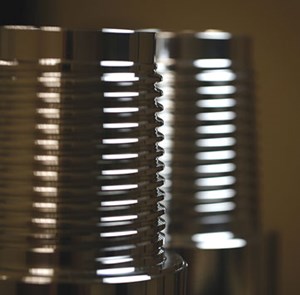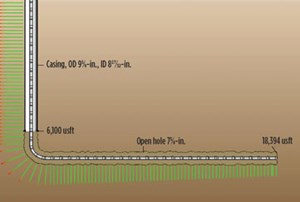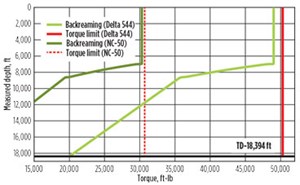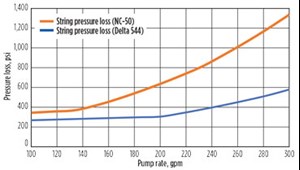Fourth-generation drill pipe connection enhances land drilling, reduces pipe maintenance
Double-shouldered drill pipe connections developed over the past several decades have seen performance primarily as the driver of growth and change. Each generation saw successive improvements in torque capacity, and streamlining the connections’ profiles addressed the challenges of hole cleaning and hydraulics. More recently, additional development yielded enhancements to fatigue resistance and running speed. These improvements were intended to enable connection use in deviated and extended-reach offshore wells, which had previously been difficult—or impossible—to drill with earlier generations of API rotary-shouldered connections. Since these were enabling technologies, cost was of little concern during this timeframe; the advances in design so dramatically increased performance that their higher cost of maintenance could be justified.

As these premium connections began to be deployed onshore, however, maintenance costs became an issue. Factory drilling applications—where drilling and completing wells in extremely short timeframes is critical—demanded a drill pipe connection that was both high-performing and cost-effective, particularly with regard to total cost of ownership over the life of the connection. Intensive use of the existing connection technologies proved that there was room for improvement, especially if the intent was to transition the new connection to land drilling.
In response to this issue, National Oilwell Varco (NOV) engaged in a two-year R&D program to develop a high-performance, lower-cost product. The resultant fourth-generation drill pipe connection, Delta, is now in use by various companies across North America, including Quail Tools, which was first to bring Delta to the market.
CONNECTION DESIGN AND TESTING
The Delta connection (Fig. 1) had several major design considerations, which took into account the strengths and drawbacks of past generations of connections. User feedback revealed that the torque of second-generation connections (XT) was sufficient for the new connection and that, in some cases, it even exceeded the capacity of existing iron roughnecks and top drives. Tool joint dimensions remained largely the same, as they were acceptable from a fishability and hydraulics standpoint.
Two versions of the new connection—standard and streamlined—were developed to address the varying needs of land drilling. The major focus was on making the new connection more rugged, easier to use and less expensive to maintain. The following were critical components for this goal:
- Deeper stabbing and faster make-up for ease of use on the rig floor
- The use of relaxed inspection criteria from a dimensional standpoint and a new tolerance for pitting in the less-loaded thread roots sections
- More available room for refacing, as this repair is the least invasive and can be performed with portable refacers
- Increased bearing surface during spinning, to reduce in-use connection damage and rate of recut.
Finite element analysis (FEA) was performed to optimize design parameters and verify stress distribution in the Delta connection. Modeling of extreme manufacturing tolerance conditions determined the connection’s stress distribution, and axial interferences at the shoulders were imposed to simulate torsional make-up. Minimum and maximum make-up torque, as well as external tensile loads, were also simulated. The FEA simulations revealed that the dimensions and tolerance selected for the new connection could adequately handle stress states without exceeding material capabilities. In addition, the FEA results indicated that wider field inspection tolerances could be adopted to reduce repair frequency without compromising the connection’s performance.
Two-dimensional axisymmetric models of corresponding connections approximated the number of threads in contact between the pin and box at stab. Having more threads engaged than previous connections meant that Delta provided a more even stress distribution, a reduction in stab damage, and elimination of the stabbing guide as a rig floor necessity. The connection’s newly optimized geometry increased total available reface material 50%, permitting additional refaces to take place before a recut was needed, and reduced material loss by up to 30% for face-and-chase repair operations, allowing for more recuts.
Laboratory testing validated the design and performance of the Delta connection after the computer simulations were complete. Make and break testing, performed 100 times, allowed NOV to determine the connection’s galling resistance, while torque-to-yield testing validated the connection’s calculated torsional strength. Over the course of testing, the connection was examined every 10 make-and-break cycles to observe the location and severity of damage, and to determine if dimensions remained within field inspection tolerances. No damage was encountered on the shoulders or threads and the dimensions were well within tolerances after the testing.
In addition, the number of turns from stab to make-up was reduced to only 6.7 turns on average—far ahead of the 13 turns required by second-generation, double-shouldered connections—and torque-to-yield results correlated closely with the connection’s calculated torsional strength. Fatigue testing was performed in a harmonic resonant test machine to compare the Delta connection’s performance versus the second-generation connection under the same bending moment. The new connection design still outperformed the baseline connection by 243%, under the same bending moment. This enhanced fatigue resistance meant that the threader could forego the process of cold rolling the thread roots with no loss of performance.
CONNECTION FIELD TRIALS
Before deploying the new connection in a commercial application, field testing was undertaken to validate that the connection performed as intended. A prototype string of 5-in. drill pipe with streamlined tool joints was produced, and 60 joints of pipe with the new Delta connection (6⅝-in. OD × 3½-in. ID) were sent to be run at NOV’s test rig in Navasota, Texas. The 375-ton, 1,500-hp rig was equipped with NOVOS—a drilling process automation platform—as well as an ST-100 iron roughneck and TDS-11SH top drive. In addition, the stand transfer vehicle arm-racking system was used to handle stands of pipe. A section of drill pipe measuring 1,900 ft was inserted at the bottom of the string that was run on the test rig in this application.

A two-phase test program was implemented over the following three months. The first phase was used to qualify other tools, as the pipe was run in the bottom of the string while the rig drilled test wells; the second phase focused on make-and-break cycles. At the end of testing, the connections were to be inspected to determine how well they withstood field service. Three directional test wells, each with a dogleg severity high enough to expose the prototype drill pipe, were drilled for the program. The drill pipe was subjected to strenuous use during the testing period, with continual making and breaking of connections and manipulation in and out of the well.
The Delta connection was tested, using the highest strength tool joints commercially available, and the connection was exposed to the highest make-up pre-load, applying the extended maximum make-up torque (corrected by a friction factor of 1.15) of 79,000 ft/lb. For comparison, an API NC50 connection for the size and grade of pipe used has a maximum make-up torque of 38,000 ft/lb. Rig personnel were instructed not to take extra care when running the connection, and to avoid using a stabbing guide. The desire was not to expressly mimic real drilling conditions, but rather to put the connection through the most adverse conditions possible. A comparative spinning test also was run, using the same iron roughneck, to evaluate make-up speed of the new connection versus the second-generation connection. The second-generation connection required more rotations to shoulder and took 8 sec to make up; the Delta connection made up in 4 sec.

When the field trials were completed, the used drillstring components were re-inspected. After cleaning the connections to ensure proper visibility of the threads, make-up shoulders, and seal surfaces, a visual inspection was carried out. The field procedure called for extremely stringent inspection of the primary and secondary make-up shoulders (seal faces and internal torque stop, respectively), as well as thread surfaces (flanks, crests and roots) and thread profile. Though there was some handling-related impact damage and minor scoring/galling, these issues were typical of rotary-shouldered connections and not of concern. A dimensional inspection followed the visual inspection. Ultimately, both visual and dimensional integrity were maintained. Despite running the connections under intentionally harsh operating conditions and exposing the pipe to an unprecedented amount of make-up torque, there was virtually no damage to the connection. Results indicated such high durability, that new, broader acceptance criteria for the Delta connection were developed.
POST-TRIAL DEPLOYMENTS
The new connection has been used already in several fields across the U.S. for varying operator-defined reasons, with each connection size offering its own particular utility. Torque analysis (Fig. 2) revealed that a premium connection was necessary on longer laterals to deliver more torque to the drill bit. The general benefit of having a higher make-up torque with a slimmer profile has been to allow operators to exceed their prior limitations. A prime example is the use of 5½-in., 21.90-pounds per foot (ppf) Delta 544 where 5-in., 19.50-ppf NC50 was used previously. While the connections have the same tool joint OD—and therefore the same fishability—the Delta 544 connection, streamlined for a 5½-in. tube, provides a 64% increase in available torque.
Figure 3 shows the result of backreaming in 9⅝-in., 47-ppf casing. Pipe with the Delta connection can be used in the same wellbore, while providing a drastic increase in available torque—the available torque-at-bit for the Delta 544 case is 20,000 ft/lbf, while it is only 5,000 ft/lbf for the NC50 case. This type of analysis has been done routinely in WellPlan by Quail Tool’s technical services division, since the release of the Delta connection.

Operators are realizing that they can achieve more available drilling torque without compromising fishability. This is particularly useful for companies that are using rotary steerable systems, or even those rotating while drilling with a motor. Long laterals, now standard in North American unconventional shale wells, require high torque to rotate the string. Rotating often can be required to reduce the severity of buckling, even if the hole is not being drilled directly by the rotation of the string; that is, there is always a benefit of having higher torque and therefore the option to rotate the string, even if that was not the original plan. The same can be said for the use of 4½-in., 16.60-ppf Delta 425 over 4-in., 14-ppf NC40. The standard tool joint OD is the same, but the Delta connection offers a much higher make-up torque. Additional benefits of increasing the tube size include an improvement in string pressure loss and buckling resistance, Fig. 4. The lower pressure loss in the string means more pressure reaches the formation during a fracture, while increased buckling resistance translates to more weight-on-bit while sliding before causing helical buckling.
CONCLUSION
With laterals continuing to increase in length, and challenging wells demanding more robust equipment, a step change in connection technology was necessary. The Delta connection was developed to meet or exceed the performance of earlier connections, while still reducing total cost of ownership. Extensive connection design validation and testing provided valuable insight into performance differentiators, while connection field trials proved the viability of Delta for broader commercial implementation.
The Delta connection is performing in fields across the U.S. with an overall recut rate of 3.6% over a sampling base of over 40,000 connection inspections. Field use repeatedly confirms the benefits of using the new connection, as shown in the modeling performed by Quail Tools. In addition to the performance benefits of using the higher strength connection and tube in the same wellbore, Delta helps operators to realize significant reductions in the cost of pipe maintenance, due to fewer connections needing recuts—and a lower price for recuts when required. ![]()
- Coiled tubing drilling’s role in the energy transition (March 2024)
- Shale technology: Bayesian variable pressure decline-curve analysis for shale gas wells (March 2024)
- Digital tool kit enhances real-time decision-making to improve drilling efficiency and performance (February 2024)
- E&P outside the U.S. maintains a disciplined pace (February 2024)
- U.S. operators reduce activity as crude prices plunge (February 2024)
- Drilling advances (January 2024)


